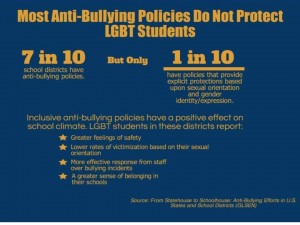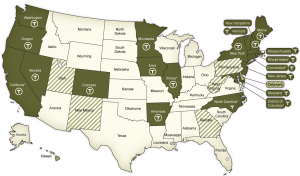America is gradually becoming more progressive with non-normative sexual issues (read: non-straight, i.e. gay, bisexual, transgender, etc.). In June 26, 2015, Supreme Court finally legalized same-sex marriage nationwide, which was an extremely debated and controversial topic for the longest time. However, the government is still not doing everything to keep the LGBT (Lesbian, Gay, Bisexual, and Transgender) community safe, especially in schools. For example, LGBT youth are more likely to engage in risky behaviors such as skipping school and abusing drugs and alcohol than their heterosexual peers. They are also more than twice as likely to be depressed and think about or commit suicide[i]. Why? Because they are more likely to be bullied. The fact that there is no federal law (read: Title IX) that protects a student’s sexual orientation and gender expression, especially in this “progressive” time in America, is alarming. So what should we school social workers do?
[i] http://www.stopbullying.gov/at-risk/groups/lgbt/lgbtyouthtipsheet.pdf
Definitions and Facts
Sexual orientation is a person’s romantic and/or sexual attraction to the opposite  sex or gender (straight), the same sex or gender (homosexual), or to both sexes or more than one gender (bisexual/pansexual). Gender identity is as simple as that—it’s the gender that one identifies with (male, female, or somewhere else on the gender spectrum). And just a note: you are biologically born with your sex, and gender is a societal conception which may or may not match with your given sex. Lastly, transgender refers to a person whose gender identity is different from their biological sex.[i]
sex or gender (straight), the same sex or gender (homosexual), or to both sexes or more than one gender (bisexual/pansexual). Gender identity is as simple as that—it’s the gender that one identifies with (male, female, or somewhere else on the gender spectrum). And just a note: you are biologically born with your sex, and gender is a societal conception which may or may not match with your given sex. Lastly, transgender refers to a person whose gender identity is different from their biological sex.[i]
Bullying is defined as “unwanted, aggressive behavior that involves a real or perceived power imbalance…[and] the behavior is repeated, or has the potential to be repeated, over time,” according to stopbullying.gov.
According to a 2013 biennial national survey by GLSEN (Gay, Lesbian & Straight Education Network) about LGBT high school and middle school students’ experiences,
- 71% heard “gay” being used in a negative way, which made 91% of them feel distressed.
- 5% heard homophobic remarks like “dyke” and “faggot.”
- 33% heard anti-transgender remarks like “tranny” and “he/she.”
- 51% heard teachers or staff say something homophobic, and 55.5% heard negative remarks about gender expression.
- 36% were physically harassed (pushed/shoved) because of their sexual orientation; 23% because of their gender expression.
- 5% were physically assaulted (punched, kicked, injured with a weapon) because of their sexual orientation; 11% for their gender expression.
- 49% were targets for cyberbullying (harassment over texting, social media like Facebook, etc.).
- With the past three points, 57% chose not to report the incident to school staff because they either thought nothing would come out of it or that it would be the situation worse. 62% of those who did report said that the staff didn’t do anything in response.
- 28% were disciplined for public displays of affection that non-LGBT students weren’t punished for.
- 18% were banned from attending a dance with someone of the same gender.
- 32% transgendered students were prevented from wearing clothing that matched their gender identity, 59% couldn’t use a bathroom that matched their gender identity, and 42% couldn’t use their preferred name.[ii]
[i] http://www.nea.org/tools/18846.htm
[ii] http://thinkprogress.org/lgbt/2014/10/22/3583011/glsen-bullying-study-2013/
What’s the Big Deal?
While Title IX, a federal law that prohibits discrimination on the basis of sex in any federal funded education program or activity[i], protects all students from sex-based harassment, it doesn’t prohibit sexual orientation discrimination. When LGBT students experienced discrimination based on their sexual orientation or gender identity, it affects their academic achievement and mental well-being. For instance, they were more than three times likely to have missed school in the past month due to a hostile school environment, they had lower grade point averages (9%-15% lower), and they had a higher rates of depression and lower self-esteem.[ii]
So why is it important to focus our efforts on changing Title IX to include the protection of students’ sexual orientation and gender identity? Only 19 states plus the District of Columbia has a law that prohibits bullying because of sexual orientation and gender identity, while 24 states don’t have a law that protects LGBT students.[iii] It is a violation of human rights to be discriminated against due to sexual orientation and gender identity. Every student should feel safe in their school environment and should not constantly feel threatened by others due to being themselves, therefore it’s up to us to persuade politicians to take the right stand and eradicate the anti-LGBT hostility. We can help save lives.
[i] http://www.justice.gov/crt/overview-title-ix-education-amendments-1972-20-usc-1681-et-seq
[ii] http://www.glsen.org/article/glsen-releases-new-national-school-climate-survey
[iii] http://www.lgbtmap.org/equality-maps/safe_school_laws
What Can We Do?
- Advocate for federal comprehensive anti-bullying policies (revamp Title IX). Most schools have anti-bullying policies that don’t include the protection of sexual orientation and gender identity. When schools have a comprehensive policy, LGBT students were less likely to be verbally harassed and more likely to have staff intervene when it happened.[i] However, this is a state by state case. We need to nationalize this comprehensive policy. Write to policy makers and government officials, especially those on the conservative side, pushing for Title IX to prohibit sexual orientation discrimination. Also, if you are in a state that doesn’t have a comprehensive anti-bullying policy, write to your state legislators.
- Encourage Gay-Straight Alliances (GSA) at your local school. GSA’s made LGBT students feel safer in school due to experiencing less harassment or discrimination.
- Don’t be silent! If you see someone being bullied, speak out. Don’t perpetuate the harassment and discrimination by being silent. Help foster a safer atmosphere. Get training in bullying prevention and intervention, and if your school doesn’t offer a program, push for one or get help with starting one.
- Get educated. You can learn more about the LGBT community here: http://www.lgbt-education.info/, http://www.glsen.org/, https://www.aclu.org/issues/lgbt-rights
[i] http://thinkprogress.org/lgbt/2014/10/22/3583011/glsen-bullying-study-2013/
